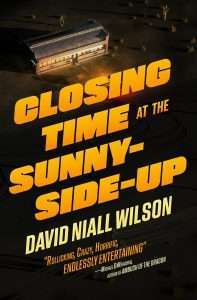Adrian Collins's Blog, page 16
June 24, 2025
The best dark fantasy and science fiction books of 2025 so far
The first half of 2025 has much to offer fans of dark and grimdark fantasy and science fiction. From dark flintlock fantasy horror to dysfunctional backstabbing families, a band of misfit anti-heroes to all-out war in an infinitely large library, there is something on our list for just about everybody. We are very fortunate to have been provided with heaps of amazing review opportunities so far this year, and from those we have compiled our team’s choices for the best of dark and grimdark SFF so far in 2025.
Grave Empire by Richard Swan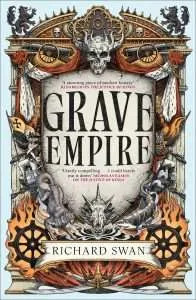 Author Richard Swan takes us back into the Empire of the Wolf with Grave Empire, the dark flintlock fantasy horror with sweeping epicness, an intense and building sense of dread, and characters grimdark fans are going to really enjoy. Fans of The Justice of Kings, The Tyranny of Faith, and The Trials of Empire are in for an absolute treat, and new readers can pick this up without having read the previous trilogy.
Author Richard Swan takes us back into the Empire of the Wolf with Grave Empire, the dark flintlock fantasy horror with sweeping epicness, an intense and building sense of dread, and characters grimdark fans are going to really enjoy. Fans of The Justice of Kings, The Tyranny of Faith, and The Trials of Empire are in for an absolute treat, and new readers can pick this up without having read the previous trilogy.
Read the rest of our review here.
About the BookFrom critically acclaimed author Richard Swan, Grave Empire begins the epic tale of an empire on the verge of industrial revolution, where sorcery and arcane practices are outlawed – and where an ancient prophecy threatens the coming end of days.
Blood once turned the wheels of empire. Now it is money.
A new age of exploration and innovation has dawned, and the Empire of the Wolf stands to take its place as the foremost power in the known world. Glory and riches await.
But dark days are coming. A mysterious plague has broken out in the pagan kingdoms to the north, while in the south, the Empire’s proxy war in the lands of the wolfmen is weeks away from total collapse.
Worse still is the message brought to the Empress by two heretic monks, who claim to have lost contact with the spirits of the afterlife. The monks believe this is the start of an ancient prophecy heralding the end of days—the Great Silence.
It falls to Renata Rainer, a low-ranking ambassador to an enigmatic and vicious race of mermen, to seek answers from those who still practice the arcane arts. But with the road south beset by war and the Empire on the brink of supernatural catastrophe, soon there may not be a world left to save…
Read Grave Empire by Richard Swan, Recommended by AdrianThe Diplomacy of the Knife by C.M. Caplan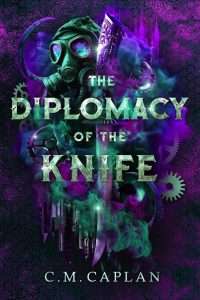 We don’t know what type of dark alchemy happened in C.M. Caplan’s mind while writing The Diplomacy of the Knife, but this second instalment in the Four of Mercies series is absolutely batshit crazy in the best way possible. It’s bigger, better, darker, filthier, more complex, more gut wrenching, more deliciously deranged, and it just bleeds with a manic ‘WHAT THE FUCK?’ energy that is honestly unparalleled. In other words, this is how you write one hell of a satisfying sequel! If you are ready for an exceptionally inventive, diverse and genre-blendy feat of storytelling madness that will excite, delight, and freak you the fuck out with each new turn of the page, then we simply can’t recommend the Four of Mercies series highly enough.
We don’t know what type of dark alchemy happened in C.M. Caplan’s mind while writing The Diplomacy of the Knife, but this second instalment in the Four of Mercies series is absolutely batshit crazy in the best way possible. It’s bigger, better, darker, filthier, more complex, more gut wrenching, more deliciously deranged, and it just bleeds with a manic ‘WHAT THE FUCK?’ energy that is honestly unparalleled. In other words, this is how you write one hell of a satisfying sequel! If you are ready for an exceptionally inventive, diverse and genre-blendy feat of storytelling madness that will excite, delight, and freak you the fuck out with each new turn of the page, then we simply can’t recommend the Four of Mercies series highly enough.
Read the rest of our review here.
About the BookPetre Mercy’s had a rough time since he rode home on a cyborg horse. He’s lost a hand that’s been replaced with a mess of steel and piano string, broke his thyroid-powered sword, and helped ignite a civil war that’s engulfed the countryside.
His sister, The Queen, has ordered him to root out any traitors in Mercy House. But Petre can hardly ferret out the truth from his siblings, let alone a vast network of spies with counterplots. And every day more turncoats move against him.
If he has any hope of putting down this uprising, he’ll have to work with a sister he’s still learning to trust. But his enemies are one step ahead of him at all times. And they’re hiding in the last place he’d think to look.
Read The Diplomacy of the Knife by C.M. Caplan, Recommended by EsmayAn Inkling of Flame by Z.B. Steele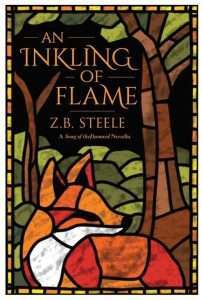 Z.B. Steele’s An Inkling of Flame is a wonderfully crafted novella, a masterclass in short-form storytelling.
Z.B. Steele’s An Inkling of Flame is a wonderfully crafted novella, a masterclass in short-form storytelling.
It introduces a captivating cast of characters—a found family forged in the years leading up to a war—and a brand new world brimming with conflict. The characters quickly grow on you, their banter and loyalty gradually giving way to a thoughtful exploration of the horrors of war and the enduring strength of the bonds that sustain us through adversity.
Fun, clever and witty, An Inkling of Flame is a fantastic introduction to the world of Song of the Damned, which I plan to dive deeper into as soon as possible!
Read the rest of our review here.
About the BookTell me how it happened…
Layne was a soldier, conscripted to fight under the Fox in a vengeance fueled march. He, and his friends, were due for a fated confrontation, one that has ended in blood and loss. Now, the inquisitors want to hear every detail of his conscription, his training, and the duel against the assassin in grey.
Read An Inkling of Flame by Z.B. Steele, Recommended by ArinaBury Our Bones in the Midnight Soil by V.E. SchwabBury Our Bones in the Midnight Soil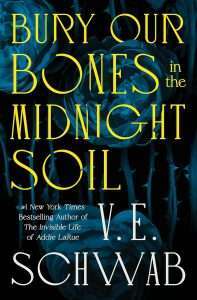 is a modern gothic novel with some light horror. Schwab masterfully handles themes of loss, love, loneliness, and many others in a delicate way. Schwab’s characters are the most central part of this story, rather than it being an action-packed plot, and stepping into the world was so easy.
is a modern gothic novel with some light horror. Schwab masterfully handles themes of loss, love, loneliness, and many others in a delicate way. Schwab’s characters are the most central part of this story, rather than it being an action-packed plot, and stepping into the world was so easy.
This is the sort of book that will speak to people’s souls. It might not have epic battles, political manoeuvring, or a quest to save the world, but it will make people feel seen. Readers will see little pieces that are like them, dotted across the three narratives. It feels like Schwab has put their everything into Bury Our Bones in the Midnight Soil, and reading it was an excellent experience.
Read the rest of our review here.
About the BookThis is a story about hunger.
1532. Santo Domingo de la Calzada.
A young girl grows up wild and wily―her beauty is only outmatched by her dreams of escape. But María knows she can only ever be a prize, or a pawn, in the games played by men. When an alluring stranger offers an alternate path, María makes a desperate choice. She vows to have no regrets.
This is a story about love.
1827. London.
A young woman lives an idyllic but cloistered life on her family’s estate, until a moment of forbidden intimacy sees her shipped off to London. Charlotte’s tender heart and seemingly impossible wishes are swept away by an invitation from a beautiful widow―but the price of freedom is higher than she could have imagined.
This is a story about rage.
2019. Boston.
College was supposed to be her chance to be someone new. That’s why Alice moved halfway across the world, leaving her old life behind. But after an out-of-character one-night stand leaves her questioning her past, her present, and her future, Alice throws herself into the hunt for answers . . . and revenge.
This is a story about life―
how it ends, and how it starts.
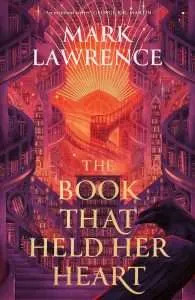 The feeling of emotional devastation lingers long after closing the back cover of Mark Lawrence’s The Book That Held Her Heart, the final volume of his mind-bending Library Trilogy, which began with the highly acclaimed The Book That Wouldn’t Burn and continued with its sequel, The Book That Broke the World. Mark Lawrence writes with wit and gusto, leading to an ending that hits so hard that I feel like the publisher should include a packet of tissues between the last page and back cover.
The feeling of emotional devastation lingers long after closing the back cover of Mark Lawrence’s The Book That Held Her Heart, the final volume of his mind-bending Library Trilogy, which began with the highly acclaimed The Book That Wouldn’t Burn and continued with its sequel, The Book That Broke the World. Mark Lawrence writes with wit and gusto, leading to an ending that hits so hard that I feel like the publisher should include a packet of tissues between the last page and back cover.
The Book That Held Her Heart is the perfect conclusion to Mark Lawrence’s most ambitious trilogy to date. Altogether, the Library Trilogy is one of the most profound and wholly original works of fiction that I’ve read in the past two decades. The Library Trilogy should place Mark Lawrence’s name in the same breath as other twenty-first century masters of speculative fiction.
Read the rest of our review here.
About the BookTwo people once connected by a vast and mysterious library are now separated and must overcome time and distance to reunite and bring peace to their worlds, in the final book of the Library Trilogy.
The fate of an infinite library hangs on one book, a book that holds the power to break the unbreakable. In the face of such forces, fragile things like hearts, worlds, and even family seem certain to fail.
The people most vital to Livira are scattered across time and space—lost, divided into factions, in mortal peril. Somehow she must bring them together and resolve the unresolvable argument that fuels the library’s war.
The bond between Livira and Evar has stretched and stretched again. Can it hold at the end, when things fall apart? Can it unite them against impossible odds?
This is the last chapter, the final page. The end threatens and no one—not characters, readers, or even the author—will emerge unscathed.
Read The Book That Held Her Heart by Mark Lawrence, Recommended by JohnThe Whisper that Replaced God II: Silent Almighty by Timothy Wolff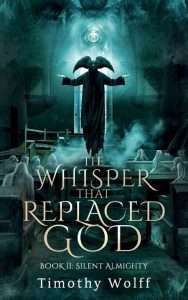 The Whisper that Replaced God II: Silent Almighty is Timothy Wolff’s follow up to his certifiably insane, sardonic, beautiful, bloody novella The Whisper that Replaced God. Reeling from the ending of book one, Lord Mute, now bathed in power, prestige, and gold, finds everything in life rather boring … until a challenger appears. Wolff ramps up the irony, prose, and bloodshed from book one and punches his ticket as a must-buy author.
The Whisper that Replaced God II: Silent Almighty is Timothy Wolff’s follow up to his certifiably insane, sardonic, beautiful, bloody novella The Whisper that Replaced God. Reeling from the ending of book one, Lord Mute, now bathed in power, prestige, and gold, finds everything in life rather boring … until a challenger appears. Wolff ramps up the irony, prose, and bloodshed from book one and punches his ticket as a must-buy author.
Read the rest of our review here.
About the BookRuling as king does not suit a man like Mute. The boredom. The monotony. The permanent stagnation…
Until he arrived. The one with the Gift of Silence. The one wielding a dagger. The one who would mold Balewind into a temple to the Silent Almighty. Lord Deaf intends to be the scream that replaced a whisper, offering one final message to the realm before it never hears again:
Bestow upon me your pain, your illness, your sorrow. Silence will absolve them all.
Read The Whisper that Replaced God II: Silent Almighty by Timothy Wolff, Recommended by Z.B.Mists of Memory by N.C. Scrimgeour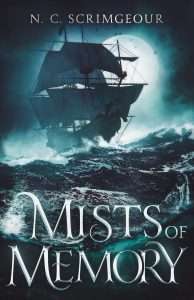 How do you follow up one of the best debut dark fantasies of recent times? By making lightning strike twice – screw that, by making it strike harder. N.C. Scrimgeour’s follow up to the flintlock folklore Scots-inspired fantasy revelation that was Sea of Souls gives us everything I loved about the original – powerful prose; dark, fog-drenched atmosphere; sublime, subtle, vibrant characterization; and pin-point worldbuilding – but twists the knife, sometimes literally, and ratchets up the drama and emotion. Mists of Memory is a non-stop, deliciously dark white-knuckle ride across waters perilous that somehow finds time to stop and give us character moments that make you and break you, sometimes on the same page. One of the must-read fantasies of the year.
How do you follow up one of the best debut dark fantasies of recent times? By making lightning strike twice – screw that, by making it strike harder. N.C. Scrimgeour’s follow up to the flintlock folklore Scots-inspired fantasy revelation that was Sea of Souls gives us everything I loved about the original – powerful prose; dark, fog-drenched atmosphere; sublime, subtle, vibrant characterization; and pin-point worldbuilding – but twists the knife, sometimes literally, and ratchets up the drama and emotion. Mists of Memory is a non-stop, deliciously dark white-knuckle ride across waters perilous that somehow finds time to stop and give us character moments that make you and break you, sometimes on the same page. One of the must-read fantasies of the year.
Read the rest of our review here.
About the BookShe had no need for the tides to be kind, not if she became the storm…
The Selkie Isles were meant to be a safe haven for Isla Blackwood, a place she could finally call home. Instead, she finds herself hunted across the sea for a pelt the Grand Admiral will do anything to recover.
But the Admiralty isn’t the only threat on the horizon. A terrible mist sickness plagues the isles, carried by the vengeful spirits of fallen selkies. To stop it, Isla will need to learn the lost secrets of her mother’s rare magic—if she can earn the trust of those who call her an outsider.
Back in the capital, Darce Galbraith prepares to set sail with the enemy fleet. Surrounded by danger, he will do all he can to sabotage their search—even if it means risking the wrath of the Grand Admiral himself.
A storm is ready to break on human and selkie alike, and only the tides know what’s waiting on the other side…
Mists of Memory is the gripping sequel to Sea of Souls, a dark fantasy saga steeped in Scottish folklore, ancient magic, and monsters that feel all too familiar. Perfect for fans of Rachel Gillig and Ava Reid.
Read Mists of Memory by N.C. Scrimgeour, Recommended by EdThe Devils by Joe Abercrombie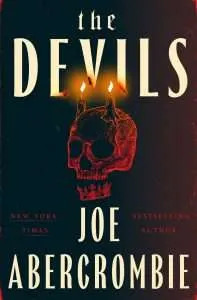 I absolutely loved The Devils by Joe Abercrombie. As a bit of a departure from Joe’s usual fare of political and complex character work, this was a plot-heavy, fast-paced rollicking good ride that made me laugh out loud several times and had several action segments that left me breathless. I hope everyone else enjoys their monster mash tour around Joe’s absolutely bonkers version of an alternative medieval Europe as much as I did!
I absolutely loved The Devils by Joe Abercrombie. As a bit of a departure from Joe’s usual fare of political and complex character work, this was a plot-heavy, fast-paced rollicking good ride that made me laugh out loud several times and had several action segments that left me breathless. I hope everyone else enjoys their monster mash tour around Joe’s absolutely bonkers version of an alternative medieval Europe as much as I did!
Read the rest of our review here.
About the BookA brand-new epic fantasy from New York Times bestselling author Joe Abercrombie, featuring a notorious band of anti-heroes on a delightfully bloody and raucous journey
Holy work sometimes requires unholy deeds.
Brother Diaz has been summoned to the Sacred City, where he is certain a commendation and grand holy assignment awaits him. But his new flock is made up of unrepentant murderers, practitioners of ghastly magic, and outright monsters. The mission he is tasked with will require bloody measures from them all in order to achieve its righteous ends.
Elves lurk at our borders and hunger for our flesh, while greedy princes care for nothing but their own ambitions and comfort. With a hellish journey before him, it’s a good thing Brother Diaz has the devils on his side.
Read The Devils by Joe Abercrombie, Recommended by SallyOne Yellow Eye by Leigh Radford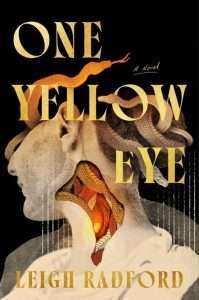 One Yellow Eye by Leigh Radford, coming this July, is a heartbreaking, confronting, deeply internal story about love, loss, and grief—with a zombie apocalypse setting just to keep things interesting! Radford brings a fresh twist to the zombie genre by having the virus stopped in its tracks and contained, but not before death and destruction turn London into a ghost town. Kesta’s husband has been infected, but she keeps him alive and restrained in their flat while she scrambles to find a cure for the very disease that has taken him from her. Her struggle with the science of the virus is skillfully explained, and the liminal kind of half-grief of living with her undead husband is entirely too approachable for anyone grappling with complicated loss. I cannot wait for One Yellow Eye to drop this summer so I can finally talk about it with fellow readers!
One Yellow Eye by Leigh Radford, coming this July, is a heartbreaking, confronting, deeply internal story about love, loss, and grief—with a zombie apocalypse setting just to keep things interesting! Radford brings a fresh twist to the zombie genre by having the virus stopped in its tracks and contained, but not before death and destruction turn London into a ghost town. Kesta’s husband has been infected, but she keeps him alive and restrained in their flat while she scrambles to find a cure for the very disease that has taken him from her. Her struggle with the science of the virus is skillfully explained, and the liminal kind of half-grief of living with her undead husband is entirely too approachable for anyone grappling with complicated loss. I cannot wait for One Yellow Eye to drop this summer so I can finally talk about it with fellow readers!
In this heart-wrenching and unique spin on the zombie mythos, a brilliant scientist desperately searches for a cure after a devastating epidemic while also hiding a monumental secret—her undead husband.
How far would you go to save your marriage? For British scientist Kesta Shelley, there is no limit.
Having always preferred the company of microbes, Kesta has spent her life looking down the barrel of a microscope rather than cultivating personal relationships. But that changed when Kesta met Tim—her cheerleader, her best friend, her absolute everything. So, when he was one of the last people in London to be infected with a perplexing virus that left the city ravaged, Kesta went into triage mode.
Though the government has rounded up and disposed of all the infected, Kesta is able to keep her husband (un)alive—and hidden—with resources from the hospital where she works. She spends her days reviewing biopsy slides and her evenings caring for him, but he’s clearly declining. The sedatives aren’t working like they used to, and his violent outbursts are becoming more frequent. As Kesta races against the clock, her colleagues start noticing changes in her behavior and appearance. She is withering away, self-medicating with alcohol, and has stopped attending her mandated ZARG (Zombie Apocalypse Recovery Group) meetings. Her care for Tim has spiraled into absolute obsession.
There are whispers of a top-secret lab working on a cure, and Kesta clings to the possibility of being recruited like a lifeline. But can she save her husband before he is discovered? Or worse…will they trigger another outbreak?
Read One Yellow Eye by Leigh Radford, Recommended by KrystleOf Empires and Dust by Ryan Cahill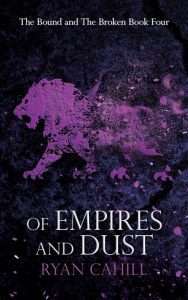 My pick is Of Empires and Dust, the fourth novel in The Bound and The Broken series, by Ryan Cahill that released at the end of March. This is officially the longest book I’ve ever read, but don’t be intimidated by the page count as Cahill’s effortless prose flows so smoothly you’ll be sailing through it, caught on a wave of astonishment at how he’s managed to keep all these threads, weaving intricate patterns into this epic tale, straight in his head. The growth of story, characters and author that this series is demonstrating is a wonder.
My pick is Of Empires and Dust, the fourth novel in The Bound and The Broken series, by Ryan Cahill that released at the end of March. This is officially the longest book I’ve ever read, but don’t be intimidated by the page count as Cahill’s effortless prose flows so smoothly you’ll be sailing through it, caught on a wave of astonishment at how he’s managed to keep all these threads, weaving intricate patterns into this epic tale, straight in his head. The growth of story, characters and author that this series is demonstrating is a wonder.
Expect more betrayals, lies, loss and revenge in this penultimate installment to the (main) series, alongside some beautifully executed musings on identity, community and belonging. This is a dark, epic masterpiece that feels like a welcome embrace against a bitter-cold and stormy night in the unrelenting wilderness. Truly, chef’s kiss.
About the BookI’ldryr viel asatar. I sanvîr viel baralun.
In fire we are forged. In blood we are tempered.
In the Aravell woodland, Calen Bryer grapples with the fallout from the Battle of Aravell. The path forward is littered with choices that will bleed him dry. But he is a Draleid, he is a guardian, and he will always stand when others call. He will be the light they look to.
His sister, Ella, lies fragmented, her mind split between worlds, her fate unknown. But the blood of the wolf is strong.
Hundreds of miles away, in the western villages of Illyanara, Dahlen Virandr leads the defense of Salme and all its inhabitants gathered from across the region. The Uraks are unrelenting, and they know only blood and death. If this is to be his end, he will enter Achyron’s Halls as a warrior who would not yield.
Below the mountains of Lodhar, Queen Kira waits in the dark while Hoffnar attempts to seize control of the Freehold and lead the dwarves towards a new dawn of war.
In Valtara, Dayne Ateres hunts those who betrayed his family, while Alina prepares her army to besiege the legendary Achyron’s Keep.
At the edges of the Burnt Lands, Rist Havel is offered a new path forward, one that few have ever trodden, one that could forge him into a mage of no equal.
With the news that Ilkya and Jormun have fallen, along with their soulkin, Eltoar finds himself face-to-face with Salara Ithan – a remnant of his past life that he had long thought dead.
As the Blood Moon taints the sky, Kallinvar and the Knights of Achyron battle tirelessly against the Shadow, doing everything within their power to hold back the darkness.
Read Of Empires and Dust by Ryan Cahill, Recommended by RaiNeed more book recommendations?We’ve been looking at the best in dark and grimdark SFF for years; here are the last few years posts to help you make sure that TBR will start teetering over you!
Best grimdark and dark SFF books of 2024Best grimdark and dark SFF books of 2023Best grimdark and dark SFF books of 2022Best grimdark and dark SFF books of 2021Best grimdark and dark SFF books of 2020Best grimdark and dark SFF books of 2019The post The best dark fantasy and science fiction books of 2025 so far appeared first on Grimdark Magazine.
June 23, 2025
REVIEW: By Blood, By Salt by J.L. Odom
By Blood, By Salt is the debut novel by J.L. Odom and the recently crowned champion of Mark Lawrence’s tenth Self-Published Fantasy Blog-Off (SPFBO), narrowly edging out second-place finisher Mushroom Blues by Adrian M. Gibson. In his own review of the book, Mark Lawrence declared By Blood, By Salt to be “one of my favourite of the 10 champions to date (selected from 3,000 entries).” This is high praise indeed from the founder of the SPFBO contest, and it’s easy to see why.
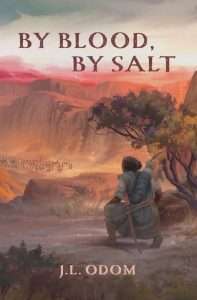 The desert world of By Blood, By Salt recalls that of Master Assassins by Robert V.S. Redick, fully realized with a long and detailed history. From the opening pages of the novel, the worldbuilding feels natural and immersive, never a chore for the reader. I especially enjoyed learning about the various religions and conflicting superstitions that are presented from multiple perspective.
The desert world of By Blood, By Salt recalls that of Master Assassins by Robert V.S. Redick, fully realized with a long and detailed history. From the opening pages of the novel, the worldbuilding feels natural and immersive, never a chore for the reader. I especially enjoyed learning about the various religions and conflicting superstitions that are presented from multiple perspective.
The lead protagonist of By Blood, By Salt is Azleta, an outsider known as the jackal who is thrust into the middle of a burgeoning political conflict. Azleta is an outstanding protagonist, easy to identiy with and full of nuance.
All characters are well developed, including the main antagonist of the novel, a devilish being known as the Sahr. It is unclear whether Sahr is human or something supernatural. One of the delights of reading By Blood, By Salt is peeling back the layers of mystery surrounding this seemingly inscrutable creature.
By Blood, By Salt is full of subtlety. The narrative is a slow burn but well worth the time invested. J.L. Odom writes with the elegance and maturity of Robin Hobb, poetic without being flowery, accessible yet having a certain gravitas that demands the reader’s full attention. The story is full of meticulously crafted details that seem repetitive at times but end up contributing to the depth of the novel.
Overall, I thoroughly enjoyed my time spent with By Blood, By Salt and recommend this book to anyone looking for a mature, complex, and elegantly written fantasy. Grimdark fans will especially appreciate the subtle but complex gray morality presented throughout the novel.
I originally reviewed By Blood, By Salt as part of the Before We Go Blog team.
Read By Blood, By Salt by J.L. OdomThe post REVIEW: By Blood, By Salt by J.L. Odom appeared first on Grimdark Magazine.
June 22, 2025
REVIEW: The Radiant King by David Dalglish
David Dalglish’s The Radiant King presents a unique premise and follows through with intricate world-building, relentless actions, sick twists, and a somewhat sobering reflection on the toll immortality takes. With a ballsy ending and a plot that explodes, The Radiant King is an immensely promising start to a new series.
“I am Sariel, ever-living child of Kaus. I am no creature, no beast, no monster.”
The Radiant King has an undeniably cool premise: six immortal siblings, five are sworn to peace; one wants a crown. These six siblings have been around for thousands of years, watching humans make mistakes and living in their midsts. Periodically, one of the siblings will tap out and commit suicide, which causes them to go into a comatose state until their body can heal.
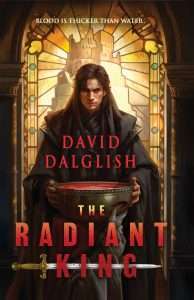 We start with one of the siblings, Faron, waking up from one of these events. His human lover has died, as they do, and he’s elected to let the pain fade with time.
We start with one of the siblings, Faron, waking up from one of these events. His human lover has died, as they do, and he’s elected to let the pain fade with time.
When he awakes, he learns that one of his siblings has broken their mantra. The six ever-living siblings in The Radiant King have two core rules: no crowns, and no giving Radiance to humans. Eder has broken both of these rules. With his brooding, cynical brother Sariel, Faron sets out to join a war with the intent of helping the war-front to take down Eder.
The world-building of The Radiant King I just adored. That premise grabs me, and Dalglish adds just enough introspection and melancholic musing to bring the Faron, Sariel, and Eder to life. Then we have some really excellent lore details. For example, humans live in a constant state of reincarnation. When one dies, they are reborn with only the faint echoes of memories of past lives. One of the ever-living siblings is in love with a human. Sometimes he tracks her down and they live a full life together, sometimes not. Details like that will make The Radiant King stick in my mind for a long time.
The plot is just as good as the world-building. We have crusades, mysteries, side-plots, torture cults, and long buried blood feuds. There’s many threads going on, but Dalglish has a firm hand on all of them. The narrative can be confusing, but never confused. I can’t go into much detail without spoilers, but if you’re a fan of Kallor’s POVs in Malazan, Covenant of Steel by Anthony Ryan or Castlevania, The Radiant King is going to be in your wheelhouse.
“No crowns. No thrones.”
Both the action and the prose in The Radiant King is serviceable. There’s moments of greatness, including a castle raid of nightmares, but for the most part, it’s good, if at times familiar. It kept my attention well, especially once I got about halfway.
My biggest critique of this book lies in the side characters. While Sariel, Eder, and Faron often feel nuanced and intriguing, the other characters–regardless of their amount of screentime–felt one-note and essentially like characters instead of people. Their dialogue, as a result, doesn’t always feel alive.
My remaining complaint of The Radiant King is the pacing feels off in the beginning. Getting through the first chunk wasn’t a chore, but the back-half is significantly better.
With those complaints mentioned, I do still highly recommend this for readers whose primary interest in fantasy books is plot or world-building centric. There’s tons of great stuff in The Radiant King, and the ending is one that blew my mind with its moxie. I’ll be waiting for book two with great anticipation.
Read The Radiant King by David DalglishThe post REVIEW: The Radiant King by David Dalglish appeared first on Grimdark Magazine.
June 21, 2025
REVIEW: Closing Time at the Sunny-Side-Up by David Niall Wilson
Closing Time at the Sunny-Side-Up is a crime thriller/sci-fi black comedy by David Niall Wilson in the style of Quentin Tarantino and David Lynch (Lost Highway more than Twin Peaks). David Niall Wilson is a two-time Stoker award winning author, and I’ve enjoyed his horror novels before this slightly more grounded but nevertheless deranged story of murder, cops, and mad science. If you want an enjoyable romp with a copious body count, then this is the book for you.
The premise of Closing Time at the Sunny-Side-Up is that a man, Sam, walks into a diner after having committed murder and in his stunned state, gives his gun to the waitress, Delilah. Delilah promptly eliminates her perverted boss and becomes his best customer/partner in crime. From there, the pair end up on the run with their bodies being cleaned up by a deranged professor experimenting with his new corpse-based biofuel. The surreal cast of characters just keeps growing as they head down toward a natural disaster in Mexico in hopes of finding more bodies for their experiment.
From the beginning to end, Closing Time at the Sunny-Side-Up is a great story of oddball characters in a heightened reality. The stakes begin with a pair who decide murder is the best way out of their shared humdrum lives and then just keeps growing alongside the body count. The science element of the biofuel has the potential to change the world but it’s also something that has the practical benefit of getting rid of corpses very quickly.
Closing Time at the Sunny-Side-Up is a world where there doesn’t appear to be much morality, but it’s played for laughs rather than horror. Each character is more concerned with how the bodies impacts their immediate plans rather than any actual worry regarding the loss of human life. Their ability to escape any consequences for their action also encourages more gleeful mayhem. The comparison with Tarantino is deliberate and you can’t help but wonder if they’ll end up at a bar full of vampires (they don’t but instead the scientists get mistaken for a UFO at one point).
While the sci-fi elements of Closing Time at the Sunny-Side-Up are light, they are still very relevant with the looming crisis of global warming and the lack of renewable resources being a subtle but consistent theme. The biofuel is something that has the potential to be a game changer to the planet, but everyone is too busy figuring out how to get rid of the people they don’t like to worry about its greater potential.
Sam and Delilah are fantastic characters, and their story is both comedic as well as dramatic in a way that mixes well with the larger issues. However, just about everyone leaps across the page. The sheriff and police officers are as bamboozled by the weird events and strange cast as anyone else.
In conclusion, Closing Time at the Sunny-Side-Up a solid and entertaining novel that is enjoyable from beginning to end. If you want a crime drama with just the barest hints of how futurism will only make humanity’s worst impulses easier then this is the book for you.
Read Closing Time at the Sunny-Side-Up by David Niall WilsonThe post REVIEW: Closing Time at the Sunny-Side-Up by David Niall Wilson appeared first on Grimdark Magazine.
June 20, 2025
REVIEW: The Burial Tide by Neil Sharpson
Neil Sharpson officiates an unholy marriage of Irish folklore and psychological horror in The Burial Tide, an expertly crafted novel that hooked me from the first page and never released its iron grip on my attention till the very end.
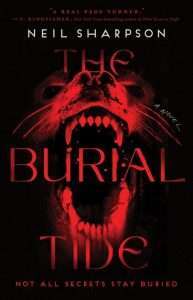 The opening scene of The Burial Tide will haunt me for years to come, as our lead protagonist, Mara Fitch, awakens in a daze, realizing that she’s been buried alive and must claw her way out from her wooden coffin. The claustrophobia of Mara’s entombment is just a precursor to her isolation on the remote Irish island of Inishbannock. Stricken with amnesia, Mara must rely on the suspicious small-town populace to reconstruct her own sense of self.
The opening scene of The Burial Tide will haunt me for years to come, as our lead protagonist, Mara Fitch, awakens in a daze, realizing that she’s been buried alive and must claw her way out from her wooden coffin. The claustrophobia of Mara’s entombment is just a precursor to her isolation on the remote Irish island of Inishbannock. Stricken with amnesia, Mara must rely on the suspicious small-town populace to reconstruct her own sense of self.
Inishbannock is full of secrets and proves to be the perfect setting to blend mystery and horror. The influence of Irish folklore is not obvious at first but gradually builds throughout the novel. The Burial Tide is highly recommended for fans of Shauna Lawless, especially if her Gael Song grimdark fantasy series left you hungry for more hauntingly dark Irish lore. It is especially interesting to see how Neil Sharpson and Shauna Lawless begin with the same mythos but then take it in wildly different directions.
Sharpson’s razor-sharp prose is a joy to read. My only minor criticism of the novel is its use of multiple points of view. I feel like the carefully cultivated claustrophobia of the novel would have deepened even more if we were to remain trapped in Mara’s mind for the full duration of the story. But this is a minor complaint in a novel that I thoroughly enjoyed.
Altogether, from its first scene to the last, The Burial Tide is a delectable feast for readers craving their next dose of folk horror.
Read The Burial Tide by Neil SharpsonThe post REVIEW: The Burial Tide by Neil Sharpson appeared first on Grimdark Magazine.
June 19, 2025
REVIEW: The Ice by Ryan Cahill
The Ice is the third accompanying novella in The Bound and the Broken series by Ryan Cahill, and is meant to be read between books 3 and 4 (Of War and Ruin, Of Empires and Dust, respectively). If you read it too soon, you might encounter spoilers, if you don’t read it before Of Empires and Dust, you’re missing out on valuable information that enriches the vast story of this series.
 The Ice focusses on Aeson Virandr as a singular POV as he leads a dire, bloody and deadly trek across the frozen lands of Valacia to find a dragon egg. The dragons of Epheria haven’t hatched in 400 years and Aeson, in his desperation, hopes an egg from Valacia could offer a sliver of hope for something different. The Ice shows us a side of Aeson we haven’t seen much of in the novels; a man steeped in desperation and fear, struggling to handle the emotions he experiences after nearly 400 years of feeling very little of anything.
The Ice focusses on Aeson Virandr as a singular POV as he leads a dire, bloody and deadly trek across the frozen lands of Valacia to find a dragon egg. The dragons of Epheria haven’t hatched in 400 years and Aeson, in his desperation, hopes an egg from Valacia could offer a sliver of hope for something different. The Ice shows us a side of Aeson we haven’t seen much of in the novels; a man steeped in desperation and fear, struggling to handle the emotions he experiences after nearly 400 years of feeling very little of anything.
Aeson is afraid for the lives of his sons, Dahlen and Erik, and will do anything to keep them safe. Everything he feels is exacerbated in their quest across the Valacian tundra, as their party is slowly and brutally whittled down by the strange, unknown and dangerous creatures seeking to protect their home. From the novels, we know Aeson, Dahlen and Erik make it back with a dragon egg, and The Ice is here to expand on just how much was sacrificed to get it.
Despite being a supporting novella, The Ice has a lot to offer. There’s beauty, mystery and secrecy in Valacia as Cahill expands the known world beyond the continent of Epheria and adds a great deal of extra flavour that will broaden the scope and horizon of any theories you may have for where The Bound and The Broken is heading. My heart sings with the potential!
Although we know the Virandr trio are going to survive Valacia, Cahill has managed to write The Ice in such a way that nevertheless instills tension. The story ties nicely back into Of Blood and Fire towards the end as Aeson, Dahlen and Erik escape a betrayal at sea and make it into Milltown just as, we know, Calen, Rist and Dann are celebrating their successful Proving.
Cahill has, once again, brought us a grimdark gem with The Ice that fits in perfectly with the rest of the series while offering something new and exciting in the same package. As companion novellas go, those in The Bound and the Broken are proving to be essential reading.
Read The Ice by Ryan CahillThe post REVIEW: The Ice by Ryan Cahill appeared first on Grimdark Magazine.
June 18, 2025
REVIEW: A Song of Legends Lost by M. H. Ayinde
I’ll admit it: I judged a book by its cover. I saw a giant flaming figure towering over a smaller warrior and thought, “Oh wow, that looks cool,” and decided M. H. Ayinde’s debut novel, A Song of Legends Lost, would be a good read. Luckily for me, this snap judgement proved to be correct; Ayinde’s science fantasy epic was a tremendous read and one I enjoyed, even though it isn’t quite what I expected. I was genuinely surprised to realise that this was Ayinde’s debut novel. It is exceptionally well written. She keeps on top of the multiple perspectives and blends the plot and the characters in an engaging and entertaining way. Also, props to artist Richard Anderson because that cover is superb.
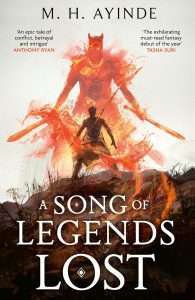 Set in secondary fantasy world of the Nine Lands, A Song of Legends Lost is a story of war and rebellion. Here, a small group of noble bloods are called to be Invokers. They are warriors who can summon the spirits of their Ancestors and wield their powers in battle. Until Temi, a low-blood commoner, accidentally invokes and discovers it could be the key to ending the war that has been waging for generations and tipping the balance of power away from the nobles.
Set in secondary fantasy world of the Nine Lands, A Song of Legends Lost is a story of war and rebellion. Here, a small group of noble bloods are called to be Invokers. They are warriors who can summon the spirits of their Ancestors and wield their powers in battle. Until Temi, a low-blood commoner, accidentally invokes and discovers it could be the key to ending the war that has been waging for generations and tipping the balance of power away from the nobles.
If you like epic fantasy with a slightly darker edge, A Song of Legends Lost is probably a read you will enjoy. If you like your epic fantasy with a slightly darker edge and a science fiction twist (like, for example, Mark Lawrence’s The Library Trilogy), then A Song of Legends Lost would definitely be a good book for you to pick up.
Ayinde has given us many treats as fans of the genre, with maps, an extensive character list, and multiple points of view to follow in the novel. Temi, the commoner who can invoke, is one of the five perspectives in the story. There is also Jiano, a noble, Father Boleo, a monk, Elari, a warrior, and Runt, a pot girl. Ayinde’s ensemble cast covers almost all walks of life, and it creates a story that the reader hears from a range of people and places in this vast world. Rarely for a multiple POV novel, I did not have a favourite viewpoint in A Song of Legends Lost. I found each of them equally as compelling and enjoyable as the others.
However, the science fiction elements surprised me as, initially, there was nothing to suggest that A Song of Legends Lost wasn’t a straight-up epic fantasy novel. I tend not to enjoy science fiction books, so when these elements came into play, I was worried it would spoil the story. I was pleasantly surprised to find it did not, and Ayinde wove fantasy and sci-fi together in a way that would make the novel appeal to fans of both genres. Also, A Song of Legends Lost is a rare bird in today’s fantasy world because it has no romantic plot elements. This might feel very refreshing to some readers and certainly makes the novel stand out at a time when everything else seems to be being shoved under the romantasy label.
An element that I struggled with in A Song of Legends Lost was the novel’s structure. It isn’t that there are multiple POVs; it is the fact that we switch between only two perspectives for the first part of the novel, and then the others are introduced. It felt like it was jarring to follow these new voices suddenly, and then it was too long before we returned to the earlier characters. But I am reserving judgment on this and won’t go so far as to call it a fault because I know I was reading A Song of Legends Lost in a very disjointed way. Reading it in tiny chunks and spreading it over a few weeks may be why the structure didn’t click with me rather than the writing. Reading like this also means I can’t comment on the pacing of Ayinde’s writing. However, I was interested enough to keep coming back, and it flowed nicely when I could read more than a chapter at a time.
A Song of Legends Lost is a massive science fantasy epic, with a wide cast of characters and detailed worldbuilding. Ayinde is a writer to keep an eye on in the fantasy world and hopefully we will get more of the same from her as The Invoker Trilogy continues. Thank you to M. H. Ayinde and the Orbit team for sending us a copy of A Song of Legends Lost.
A Song of Legends Lost by M. H. AyindeThe post REVIEW: A Song of Legends Lost by M. H. Ayinde appeared first on Grimdark Magazine.
June 17, 2025
REVIEW: Of War and Ruin by Ryan Cahill
The third instalment in The Bound and The Broken series by Ryan Cahill, Of War and Ruin turns up the heat as everything gets bigger, darker and more sinister. This deep into a series, some spoilers are almost certainly going to slip into the reviews – you have been warned! The end of Of Darkness and Light left us with some shocking revelations and satisfyingly frustrating cliffhangers, as Cahill kept tantalising answers just beyond our grasp, ready to hook us back in with Of War and Ruin.
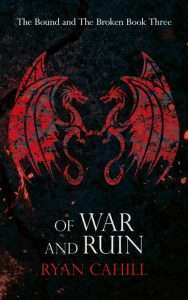 The Knights of Achyron – a small, elite cohort of warriors imbued with a semblance of a god’s power – are reeling from the loss of their Grandmaster who had guided them for centuries. His replacement, Kallinvar, is already conflicted about his ascent to lead the Knights when he begins to hear Achyron’s voice in his head. To make matters more complicated, one of the Knights is Calen’s older brother, who was thought to be years-dead from an Uruk raid on their village. A Knight is expected to leave their past behind them when they accept Achyron’s sigil, and Arden finds it difficult to learn the rest of his family are dead and Calen is the new Draleid.
The Knights of Achyron – a small, elite cohort of warriors imbued with a semblance of a god’s power – are reeling from the loss of their Grandmaster who had guided them for centuries. His replacement, Kallinvar, is already conflicted about his ascent to lead the Knights when he begins to hear Achyron’s voice in his head. To make matters more complicated, one of the Knights is Calen’s older brother, who was thought to be years-dead from an Uruk raid on their village. A Knight is expected to leave their past behind them when they accept Achyron’s sigil, and Arden finds it difficult to learn the rest of his family are dead and Calen is the new Draleid.
What neither Calen or Arden know, however, is that their sister Ella is alive and joining the same fight they are elsewhere on the continent. Having escaped the Empire in Of Darkness and Light, Ella has joined the rebellion and is going through her own path of self-discovery. Ella has druid blood and her bond with the wolfpine Faenir is growing stronger as she leans into it. Working with the rebellion, she is captured by the same Imperial company that both Farda and Rist are with, prompting an explosive reunion.
Rist has ascended to the ranks of the Battlemages and continues to be unknowingly manipulated by those he has grown to trust. Many times I found myself mentally screaming “FOOL OF A TOOK” at Rist through these pages, frustrated to see the anguish coming in his future when he can’t. Farda, meanwhile, is continuing to question his faith and commitment to the Empire since catching feelings from his time with Ella. When you’ve cared about nothing and no one for 400 years, I imagine suddenly feeling something again is a bit of a shock.
Our trio of D-named lads – Dahlen, Dann and Dayne – are all facing struggles, battles and pain in their own ways. Dahlen is the character to look to for exploration of the development of what we would call Post-Traumatic Stress, as the fighting and suffering within Durakhdur continues to take its toll on him mentally. Dayne has numerable pressures exerted on and over him now he has been revealed as still living to the rest of Valtara, pulling his loyalties left and right. Dann is caught in evermore dangerous situations and shows a lot of growth in Of War and Ruin, slowly growing into a hero in his own right.
There is a lot going on throughout Of War and Ruin and, at over 1,400 pages, that could be an understatement. As with all of Cahill’s writing, it feels fast-paced and despite being the longest book I’d ever read (at that point) it didn’t feel arduous at any point. Clearly, Cahill has exerted some reverse-TARDIS magic over his books as they are epic and expansive enough to feel like 1,400+ pages, while at the same time the actual reading of them feels like it wasn’t that long. Truly, he is a druid of the pages.
Read Of War and Ruin by Ryan CahillThe post REVIEW: Of War and Ruin by Ryan Cahill appeared first on Grimdark Magazine.
June 16, 2025
REVIEW: The Gorge
The Gorge is a movie starring Anya Taylor-Joy and Miles Teller. It is an Apple TV movie and thus something that a lot of people will miss because they don’t pick up a particular streaming service. That would be a shame because this is the sort of movie that really deserved a theatrical release. Is it a groundbreaking piece of cinema?
 No, it’s very much a standard sci-fi action movie with a few twists as well as an unusually well-developed love story. Really, I’d argue it reminds me of a lot of video game plots and wouldn’t have been out of place as a Resident Evil installment but that isn’t an insult. Because it would have been a very good Resident Evil installment.
No, it’s very much a standard sci-fi action movie with a few twists as well as an unusually well-developed love story. Really, I’d argue it reminds me of a lot of video game plots and wouldn’t have been out of place as a Resident Evil installment but that isn’t an insult. Because it would have been a very good Resident Evil installment.
The premise is that Levi Kane (Teller) is a US Marine sniper that has found himself drifting through life after his term of service. Levi takes jobs for private military contractors less because of the money, which he’s implied to have plenty of, and more because he simply doesn’t know what else to do with himself.
Contrasting him is Drasa (Anya Taylor-Joy), a Lithuanian sniper, who has sent most of her money home to her family but will soon no longer have one as her father is in the final stages of cancer. Both end up hired by a mysterious employer to watch opposite sides of a gorge in an unknown location.
This assignment is bizarre from the start with most of their duties consisting of watching the automated defenses and only rarely taking pot shots at strange creatures that emerge from the gorge called Hollow Men. Okay, less strange than tree zombies. Yeah, I said tree zombies. They’re zombies that are part tree: it’s in the name. Perfect for video game enemies.
Our snipers have no backup and the opposite sides of the gorge have apparently been watched since the end of World War II. Neither Levi or Drasa are especially curious individuals but even they are deeply troubled by the fact that zombies are real and are being contained in a single unmarked location.
What’s interesting about this movie is that it is mostly not about the zombies or the role of the snipers in keeping the monsters imprisoned below. No, oddly enough, it is the burgeoning romance between two broken people who mostly communicate with signs as well as music. Levi and Drasa are a surprisingly cute couple and I would have happily watched the entire movie with just them falling in love despite their tortured pasts. Roughly halfway through the movie, though, they get into the Gorge and exposed to the evil done by the Umbrella Corporation. Err, Darklake Corporation.
The latter half of the movie results in them exploring the gorge itself and that is full of some genuinely creepy body horror and monstrous events. It feels very video game-y with found footage that just so happens to reveal everything that is going on and is still intact decades later. Oh, and it’s right next to some of the evidence that shows their employers are, GASP, not on the level. From there, the movie continues to its expected conclusion and is a solid ride.
The Gorge could have been a bad sci-fi action movie that was, nevertheless, a lot of fun. Instead, the romance and chemistry between the lead actors make it so it’s a good sci-fi action movie that is cheesy as hell. The writers remembered that we might want to care about the protagonists and gave us reason to do so. Even those who don’t like romance will probably enjoy the unconventional one between two super-snipers.
The post REVIEW: The Gorge appeared first on Grimdark Magazine.
June 15, 2025
An Interview with James Lloyd Dulin
We got the chance to sit down with James Lloyd Dulin—author of the dark fantasy Malitu trilogy—to talk about writing, basketball, life, and his upcoming series finale Only A Grave Will Do. James has three books out and Only A Grave Will Do releasing on June 24th, 2025.
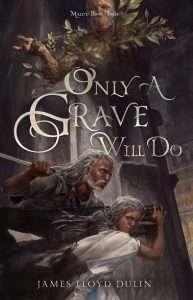 [GDM] Hey James, thanks so much for doing this interview! To get things started, can you give a quick pitch of your series to the people reading this interview?
[GDM] Hey James, thanks so much for doing this interview! To get things started, can you give a quick pitch of your series to the people reading this interview?
[JLD] A recluse warrior faces his past, risks warring factions, and delves back into the rebellion he abandoned to mentor a war orphan hell-bent on revenge. He will fight an empire to keep her from recreating his life of regrets.
If you enjoy Robin Hobb, Patrick Rothfuss, or Evan Winter, Malitu should be on your TBR.
[GDM] Only A Grave Will Do, the culmination of your series, comes out on June 24th. How are you feeling about everything?
[JLD] I’m still processing it all. I have been looking forward to jumping into new worlds and new stories. At the same time, I tear up reading the final chapters of Only a Grave Will Do, realizing that this will be the last time I write about these characters. This story has existed in my head for over 6 years. It is extremely satisfying to finish sharing it with the world, and sad to say goodbye to it.
[GDM] What are you currently reading?
[JLD] I am juggling a couple of books. I just finished listening to The Will of the Many, and I’m working my way through the Murderbot novellas. I usually have an audiobook and an ebook/physical book going at all times.
[GDM] In your interview with Rebecca Crunden, you stated that Hakeem is one of your favorite basketball players. What’s your ideal staring five?
[JLD] My favorite team ever was the 2004 Detroit Pistons because they were a bunch of amazing role players who came together as a team to win a championship without the star power of other teams. So I’m not throwing the best players out there in each role. I want a team I think will work well together.
Isiah Thomas (81-94, not current NBA), Reggie Miller, LeBron James, Tim Duncan, Hakeem Olajuwon. I think these guys would know how to move the ball around and work together.
[GDM] This is a bit of a darker question, but what’s the closest you’ve ever been to quitting?
[JLD] I’ve never been close to quitting writing. I come close to quitting or at least stepping back from publishing all the time. It’s hard when you aren’t meeting your personal metrics for success and you reflect on what you are giving up to keep everything going. I am investing time and money on publishing that could go to my family. I do my best to find balance, but there are always sacrifices—nights that I could spend relaxing with my wife. My hope is to look back on this and feel like I made the right decisions with my time. If I don’t make space for my creative pursuits, I cannot be the best version of myself. However, I can never let my creative needs take priority over the people I love.
There is never enough time. I will probably always wonder if I am making the right decisions.
Dark enough for Grimdark Magazine?
[GDM] Other than writing, what fills your time?
[JLD] Mostly, work and family. I have two young children who have enough energy to replace that damn bunny with the bass drum. We play basketball, color, and roughhouse until they fight sleep like it was their worst enemy on a daily basis.
I am fueled by anything that allows me to be creative. I love cooking, especially trying out new dishes. Although, age is really trying to steal my love for spicy food. Which is my way of saying, my time is filled with getting older, and it sucks.
[GDM] Have any movies impacted or inspired your writing?
[JLD] Pan’s Labyrinth is one of my favorite movies, and it has definitely had an impact. I want to find the flicker of imagination in the dark realities of the world. There is something so stirring about beauty surrounded by darkness.
I’m also a sucker for movies with redemptive father/son relationships. In a similar way to Pan’s Labyrinth, there is something that affects me about love pushing through pain and trauma. Warrior (2011) is my favorite example of that, and I would definitely say those relationships inspire the way I think about characters.
[GDM] What’s the best album to write to?
[JLD] Silence. Absolute silence.
I am drawn to lyrics. So writing to music is a good way to distract me. My mind latches onto the words. Occasionally, I will throw on some lofi instrumental music, but that is mostly when I’m editing.
[GDM] What’s next for James Lloyd Dulin?
[JLD] More stories. There will always be new stories. I have a rough idea of a spinoff series in the same world as Malitu, but I think I will come back to that later.
For now, I want to explore a new world. During the breaks when editors have had Only a Grave Will Do, I have been outlining a series loosely inspired by Arcane. And when I say loosely inspired, I mean vibes only. I loved the show, and it made me want to write something with a similar style. So I hope to start writing that soon.
[GDM] Thanks for doing this interview! Wanna leave a last message for the readers? Beg them to pick up your books or spit at them in bloody defiance?
[JLD] Does begging work? I’ll do it. Do I need to film it?
Seriously, for anyone who has read this far in the interview, thank you. Give Malitu a try. If it doesn’t do it for you, just buy the rest and read something else. Is that too much to ask?
Read Only a Grave Will Do by James Lloyd DulinThe post An Interview with James Lloyd Dulin appeared first on Grimdark Magazine.

